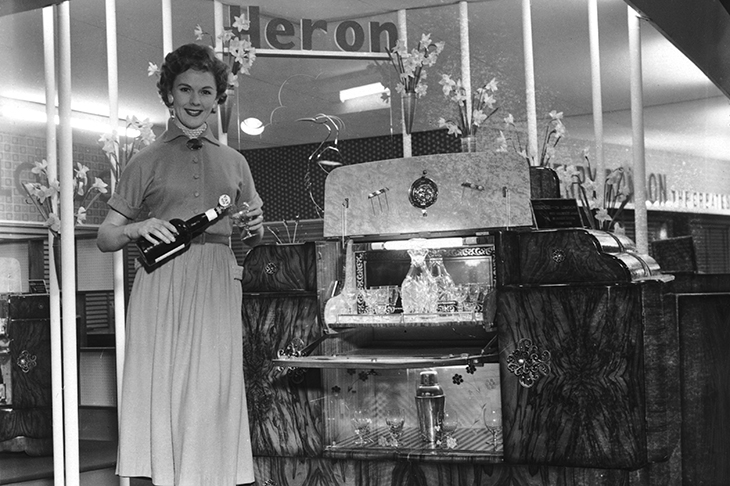When I mention to people that I have written a book about home bars, the most common response is, ‘my parents/grandparents/swinging uncle used to have one of those globe cocktail cabinets’. The other thing they mention is Only Fools and Horses. For years, having a bar in your home was seen as the height of bad taste.
It’s a far cry from the home bar’s 1950s heyday. After the second world war, people were spending more time at home, but still wanted to lead the cocktail lifestyle. It was the suburban American dream: after a hard day’s work, drive home in your shiny new Chevrolet, put Frank Sinatra’s Songs for Swingin’ Lovers on your state-of-the-art hi-fi while your wife knocks you up a martini at your home bar. In austerity Britain, we had to make do with a Morris Minor and Scandinavian–inspired cocktail cabinets bought on hire purchase.
As the 1950s gave way to the 1960s, minimalism started to go out of fashion and interior design became more riotous. We can see the change from a film like Sabrina (1954) where Humphrey Bogart makes Audrey Hepburn a daiquiri from his sleek mid–century sideboard in probably cinema’s greatest office, to Anne Bancroft trying to seduce Dustin Hoffman in The Graduate (1967) at a kitsch home bar with a big glowing sign on saying ‘bar’. From there it’s just a small step to 1978’s Foul Play, in which Dudley Moore plays a swinger with a piano that turns into a (let’s face it, completely fabulous) bar. Home bars became the subject of derision. Eventually they were relegated to the garage or shed.
Tastes had changed. The aspirant middle classes were turning to wine. When I was growing up in the 1980s, only older people drank spirits before a meal. But now wine sales are declining while gin is booming. The drinks my grandparents used to enjoy: whisky and ginger, brandy and soda, and gin and It, have returned, and if you’re making them regularly, you need somewhere to keep bottles, glasses, shakers and so on. A proper bar is the dream, but in all but the largest rooms a bar can look a bit, well, Del Boy. So you might have to make do with a trolley, a specially designed cupboard or just a silver tray with an ice bucket. You can tell your family that your bar is a necessity, but who are you kidding? It’s about showing off, it’s about entertaining. It’s about pretending that you are Humphrey Bogart or Joan Crawford for the evening.
Prices for the top mid-century designs, especially the original Danish stuff, have increased dramatically in recent years — but you can still find bargains. People associate home bars with their grandparents and often throw them out unthinkingly, which means drinks trolleys and cabinets can still be picked up for a song at junk shops. Once you get the home bar bug, however, it can be difficult to stop. You might begin with a tasteful 1950s drinks cabinet, but before long you’ll be looking on eBay for a padded leather bar with a built-in quadra-phonic receiver. Who needs good taste? I visited a cocktail laboratory in trendy east London recently where bartenders conjured up exotic drinks using centrifuges and rotary evaporators, and there, in pride of place, was a globe cocktail cabinet. The home bar is very much back.






Comments